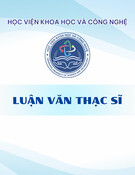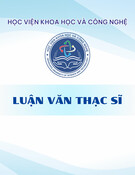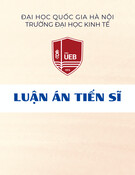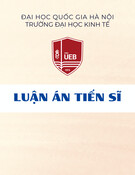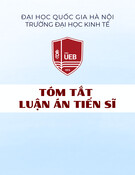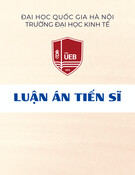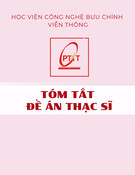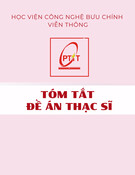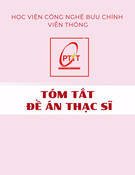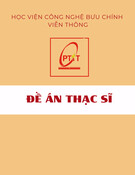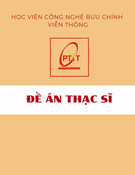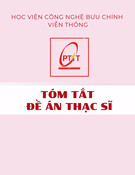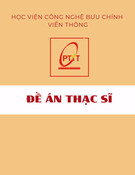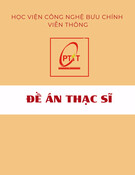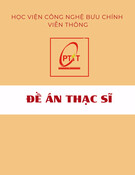
MINISTRY OF EDUCATION AND TRAINING
CAN THO UNIVERSITY
SUMMARY OF DOCTORAL THESIS
Major: PATHOLOGY AND TREATMENT OF ANIMALS
Major code: 62 64 01 02
Ha Huynh Hong Vu
Some epidemiological biology and of Fasciola sp. and
the efficacy of anthelminthic treatments in cattle
in the Mekong delta
Can Tho- 2018

I
THIS THESIS WAS COMPLETED AT CAN THO
UNIVERSITY
Academic supervisor: Assoc. Prof. DR. Nguyen Huu Hung
This thesis was defended against the Ph.D. dissertation council at the
university level.
Place: …………..
Time: ……………
1st Opponent: ……………..
2nd Opponent: ………………………
Reviewed Confirmation of Chairman
…………..
Thesis could be found at:
1. Learning Resource Center, Can Tho University.
2. National Library of VietNam.

II
PUBLISHED ARTICLES
Published Articles in journals
1. Ha Huynh Hong Vu, Nguyen Ho Bao Tran, Nguyen Huu Hung, 2014.
Identification freshwater snail intermediate host of trematoda causing
animal disease in Vinh Long and Dong Thap Province. Journal of Science,
Can Tho University, Special issue agriculture, pp 8-12.
2. Ha Huynh Hong Vu, Nguyen Ho Bao Tran, Nguyen Huu Hung, 2015.
Morphological and molecular characteristic of Fasciola sp infected in cattle
in Dong Thap province. Journal of Science-Technique of Veterinary
Medicine, 6: 63-69.
3. Ha Huynh Hong Vu, Nguyen Ho Bao Tran, Pham Duc Phuc, Nguyen
Huu Hung, 2016. Application of molecular marker-ITS-1 gene and PCR-
RFLP technique for determining large liver flucke (Fasciola sp.) in cattle in
Mekong river Delta, 2016. Journal of Science-Technique of Veterinary
Medicine, 2: 85-92.
4. Ha Huynh Hong Vu, Nguyen Ho Bao Tran, Nguyen Huu Hung, 2016.
Large liver fluke (Fasciola sp.) infection of cattle in the Mekong Delta and
results of treatment trials. Journal of Science, Can Tho University, Special
issue agriculture, pp 17-22.
5. Ha Huynh Hong Vu, Nguyen Ho Bao Tran, Nguyen Huu Hung, 2018.
The surveillance on pathological characteristics of Fasciola gigantica
infected in Mekong delta. Journal of Science, Can Tho University, Special
issue agriculture, pp 12-17.

3
Chapter I: INTRODUCTION
1.1 Rationale
According to the World Health Organization (WHO), Fascioliasis is one of
the important diseases, which is found in humans and animals. More than
2.4 million people in 70 countries were affected by the disease (WHO,
2015; Amer, 1016). In Vietnam, Fascioliasis in humans tends to increase
gradually, from 2006 to 2010. In fact, 15,764 people and cases were
infected by Fasciola sp. in 2006 and those cases increased to over 20,000
people in 2011. The disease in 52 provinces from North to South and
pathogenic species is determined mainly Fasciola gigantica (Nair et al.
2012). Fasciolosis has been demonstrated and listed in zoonosis diseases.
The disease causes by the large liver flukes which require the intermediate
host (freshwater snail species) to complete its life cycle. The Mekong Delta
possesses the geographic features such as innumerable canals, rivers,
stream which is suitable to develop agriculture: paddy rice and vegetables
as well as provide the appropriate conditions for freshwater snail
development. Moreover, livestock husbandry also great develops because
famers take advantages the source of by-product from agricultural
processing. However, most of husbandry farms are small-scale farms where
people normally use by-products from agriculture and they do not have
well knowledge about applying the techniques in animal husbandry and
veterinary. As the results, their livestocks expose high prevalence of
helminthes infection. Therefore, it is crucial to research about fasciolosis
and how to manage the spreading of this disease in order to minimize the
damage from it. The study aimed to investigate “The epidemiological,
biological characteristics of Fasciola sp. and the efficacy of anthelmintic
treatments in cattle in Mekong Delta”
1.2 Objectives
- Identifying the species, distribution, biological characteristics and
influential factors to the liver flukes infection rate in cattle the Mekong
Delta.
- Suggesting the treatment methods for infected cattle in Mekong Delta.
1.3 Scientific significance
- This is a systematic research about liver flukes Fasciola gigantica in
cattle: determining the prevalence of infection and influential factors to the
pathogen. Species were identified by morphological and molecular
characteristics (PCR-RFLP, and sequencing)
- The life cycle of Fasciola gigantica in cattle in Mekong Delta were firstly
researched: identifying intermediate host (snails). Clinical symptoms and

4
anthelminthic testing would be useful for diagnosis and treatment.
- This thesis provides documentations about Fasciola sp. infected in cattle
(Mekong Delta), and supplies academic knowledge for veterinary
parasitology books to education and training purposes
1.4 Practical significance
- The thesis results are the scientific background for recommending farmers
in effectively diagnosis, treatment and prevention liver flukes that
minimizes the economic lose as well as contributes for the sustainable
development of livestock husbandry.
1.5 Innovative contributions of the thesis
This is the first research about Fasciola gigantica in infected cattle in
Mekong Delta which were identified by applying molecular biology
techniques.
This is also first research about the complete life cycle of Fasciola
gigantica.
Gross lesions and histopathological of Fasciolosis (causing by F.gigantica)
were completely described which were provided background for quickly
diagnosis and treatments
Chapter III: CONTENT AND RESEARCH METHODOLOGY
3.1 The research contents
3.1.1 Determining the prevalence of liver flukes of cattle in the Mekong
Delta provinces
- Determining the infection rate of liver flukes of cattle in the Mekong
Delta provinces by the fecal examination and necropsy methods.
3.1.2 Identifying the species of Fasciola sp. in the Mekong Delta
provinces
- Determining the species of Fasciola sp. by analyzing mophorlogical
molecular biology chacteristics and sequencing.
3.1.3 Researching about life cycle of Fasciola gigantica
- Observing the development of the Fasciola gigantica egg outside the
definite host.
- Observing the development of the larvaes of Fasciola gigantica in
intermediate host (Lymnaea swinhoei and Lymnaea viridis) to stage
cercaria infection.
- Analyzing and recording the every development stage of Fasciola
gigantica since embronated eggs to mature in definitive host.

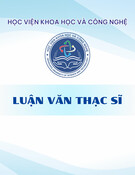
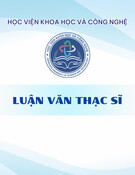
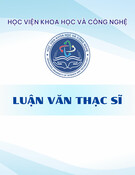
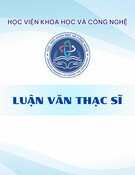
![Luận văn Thạc sĩ: Tổng hợp và đánh giá hoạt tính chống ung thư của hợp phần lai tetrahydro-beta-carboline và imidazo[1,5-a]pyridine](https://cdn.tailieu.vn/images/document/thumbnail/2025/20250816/vijiraiya/135x160/26811755333398.jpg)
